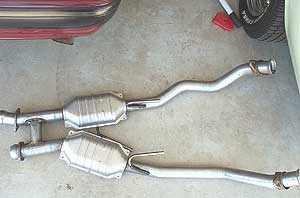 "Smog
certificate required", the three dreaded words that muscle car
owners hate to read on their registration notices. Most states now
require some sort emissions testing every one or two years in order
to register a vehicle. In heavily populated (and polluted) states
like California, the testing is especially tough because it combines
a tailpipe "sniffer" test along with a visual inspection,
where the official checks to verify all the factory smog equipment
is in place and functioning. They also look for "illegal"
aftermarket parts, which do not have E.O. (Exemption Order) numbers.
In especially "impacted" areas the testing may even be conducted
on a dynamometer, to simulate real world loads on the engine - and
no, they wont give you a dyno graph at the end of the test! "Smog
certificate required", the three dreaded words that muscle car
owners hate to read on their registration notices. Most states now
require some sort emissions testing every one or two years in order
to register a vehicle. In heavily populated (and polluted) states
like California, the testing is especially tough because it combines
a tailpipe "sniffer" test along with a visual inspection,
where the official checks to verify all the factory smog equipment
is in place and functioning. They also look for "illegal"
aftermarket parts, which do not have E.O. (Exemption Order) numbers.
In especially "impacted" areas the testing may even be conducted
on a dynamometer, to simulate real world loads on the engine - and
no, they wont give you a dyno graph at the end of the test!
As if the "smog nazis" weren't enough of a pain to deal with,
the local law enforcement agencies have made it their own agenda to pull
over, inspect, and even tow away vehicles suspected of having non smog-legal
parts or missing emissions equipment.
Back in
the day when the air was still clear, and the ozone intact, nobody thought
twice about removing a performance cars smog equipment in attempt to
free up some horsepower and reduce weight and clutter. Smog pumps, hoses,
EGR valves, and catalytic converters were quickly yanked and the aftermarket
was right there to supply better performing replacement parts. When
it came time to smog, you either bolted the stuff back on temporarily,
or took the car to your buddies shop where he hooked you up with a cert
in exchange for a six pack of his favorite brew.
Nowadays you can't even order a tail pipe from Summit without hearing
the "may not be legal for use on emissions controlled vehicles"
warning. And if you are lucky enough to still know someone still bold
enough to run a fake smog check, he better have a good bail bondsman,
since the Bureau of Automotive Repair doesn't think twice about throwing
smog cheats in jail.
 So
what is the enthusiast supposed to do? Is it possible to make decent
power and keep the environment clean? The answer is yes, and one
of the ways to do it is to run a high flow H-pipe with catalytic
converters. So
what is the enthusiast supposed to do? Is it possible to make decent
power and keep the environment clean? The answer is yes, and one
of the ways to do it is to run a high flow H-pipe with catalytic
converters.
In this article we'll show you just how clean a late-model Mustang
runs, in terms of emissions, when using three-way catalytic converters.
Then in an upcoming article we'll test the catalytic converter H
pipe at the track against an "off road" H pipe, and show
that the performance loss through converters is negligible.
The car
We took our '88 5.0 LX as the guinea pig. The car was smog tested
with the stock four-converter H-pipe, then with an off-road H, and
finally with a 2.5" two-converter H-pipe made by Car Sound.
 (You
must be subscriber )
(You
must be subscriber )
|

